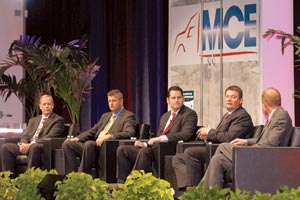Senior Reporter
Technology Advancement Can Boost Safety, Enhance Driver Recruitment, Panelists Say

PHILADELPHIA — The rapidly evolving vehicle technology landscape has led to improvements in truck safety and is helping to attract younger drivers to the industry, executives speaking at a panel hosted by Transport Topics said here Oct. 20.
Brian Kinsey, president and CEO of Brown Integrated Logistics, Rob Penner, president at Bison Transport, and Greg Pawelski, senior director of safety at Con-way Freight, talked with TT Technology Editor Seth Clevenger about the recent advancements of safety tools and technologies in trucking.
Bison Transport ranks No. 59 on the Transport Topics Top 100 list of U.S. and Canadian for-hire carriers. Con-way Freight is a unit of Con-way Inc., which is No. 4 on the for-hire TT100.
COMPLETE COVERAGE: MCE 2015
The event was part of American Trucking Associations’ Management Conference & Exhibition.
Capt. Jeff Skiles, first officer on US Airways Flight 1549, famous for his role in the “Miracle on the Hudson,” participated in the panel after keynote remarks that focused on safety programs essential to commercial transportation.
“As we try to attract newer and younger people, I think if we can make operating a truck like playing on an iPad, it would be great. We would have no problem attracting people. [Operating a truck] does require a different skill set that young people have; you just have to make the job more attractive,” Kinsey said.
At Brown Logistics, truck drivers are now referred to as “commercial vehicle operators,” he said, reflecting a broader definition of the work they do.
An exciting front for the industry is autonomous technology and new vehicle-to-vehicle communication tools designed to prevent collisions, the panelists said.
“When I think about the autonomous vehicle, it is of the future, and we look forward to that day. But in reality, what it’s doing is taking those driver-assist technologies that we have today and making them better,” Pawelski said.
Among myriad technologies used, Penner cited automated transmissions meant to help drivers focus on the road. He also mentioned the Bose Ride seats suspension systems.
Kinsey noted that Brown has adopted the use of disc brakes for safety enhancements. And Pawelski added that Con-way Freight has adopted safety systems such as collision mitigation.
While improvements in safety technology have helped reduce accidents, the speakers stressed that drivers remain the key players in freight safety. That’s why proper training of any new technologies remains essential for fleets.
“It’s all about the driver. It’s about building a culture within your organization that safety is first,” Pawelski added.
Skiles said technological advances have propelled drivers to the role of system managers, similar to the ways commercial pilots operate.
He credited his command of safety technology with helping the successful emergency landing six years ago in the Hudson River.
Before joining the panel, Skiles said the landing was not a miraculous achievement at all.
Instead, Skiles said, it was the result of a change in the airline’s culture that provided for the training, preparation and procedures for the teamwork that proved critical in saving all 155 people onboard the Airbus A320 on Jan. 15, 2009.



